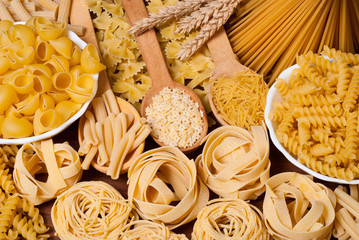How to Cook Pasta

How to Cook Pasta
How to Cook Pasta
Everyone thinks their way of cooking pasta is the right way. I’ve been asked the following questions regarding this process: How long should I cook pasta? Do I put salt in the water, and if so, how much should I use? Does cold water boil faster than hot water? Should I put oil in the water? I’ll be able to tell that my pasta is done by throwing some at the wall- if it sticks, viola! If it sticks to my brother’s/sister’s forehead, it’s definitely done. Does fresh pasta cook faster or slower than the hard kind? Should I rinse my pasta after it’s cooked?
Firstly, when buying pasta from your local market make sure that it’s made of 100% semolina (the label will say durum – wheat semolina or semolina). Pastas that use fillers and that are not 100% semolina can become mushy, and lose their shape.
For Cooking Hard Pasta:
First, and most importantly, make sure that you have plenty of water to cook your pasta. For a pound (16 ounces) of pasta, you will want a pot that holds at least 5 or 6 quarts of water. Cold water does not boil faster than hot water, so fill your pot with hot water from the tap. Place it on a high flame, then put at least ½ cup of salt into the water. That may seem like too much salt, but it’s necessary (it also adds to the seasoning of the pasta). Place a lid on the pot and wait for the water to come to a full boil. Sometimes that’s hard to do when you’re hungry, but it’s essential to having your pasta cook properly. Don’t add oil to your pasta water! Many people believe that oil helps the pasta from sticking together, but it doesn’t. Excess oil will remain on the pasta after draining, preventing sauces from clinging to the noodles. Stirring the pasta frequently will prevent sticking. After six to seven minutes, start checking the pasta. Using a fork, pull a piece of the pasta from the pot, let it cool slightly, then take a bite. When cooked properly, the pasta should be slightly firm to the bite, and not too soft. I’m sure you’re all familiar with the term “Al Dente.” Definition of “al dente” (ahl-DEN-tay): In Italian the phrase means “to the tooth” and is a term used to describe the correct degree of doneness when cooking pasta, risotto, and vegetables. The food should have a slight resistance (chewy) when biting into it, but should not be soft, overdone, or have a hard center.
The pasta should be strained through a colander and not rinsed. Make sure the pasta is completely drained before putting sauce on it. There’s nothing worse than getting a plate of spaghetti with sauce and a pool of water…yuck. Don’t rinse the pasta. This will only make the pasta cold, and wash off any excess starch that will help the sauce adhere to the noodles. Make sure that any sauce you put on you pasta is also hot; nobody likes cold food.
Cooking Fresh Pasta:
Follow all of the above tips; start checking the doneness of the pasta after three minutes.
A few other points to consider…….
- Don’t drown your pasta. You’re featuring the pasta, not the sauce.
- Serve your pasta in a bowl, not a plate. This will keep it hotter longer.
- Don’t slurp when eating your noodles…no one likes a slob.
- In Italy, pasta is eaten with a fork…not a fork and spoon.
Chef Chuck Kerber
chuck@cooksandeats.com






 in <b>/var/www/vhosts/cooksandeats.com/httpdocs/wp-content/themes/CooksandEats/sidebar.php</b> on line <b>1</b><br />
/wp-content/themes/CooksandEats/images/side-logo.png)



 in <b>/var/www/vhosts/cooksandeats.com/httpdocs/wp-content/themes/CooksandEats/footer.php</b> on line <b>13</b><br />
/wp-content/themes/CooksandEats/images/back-to-top.png)